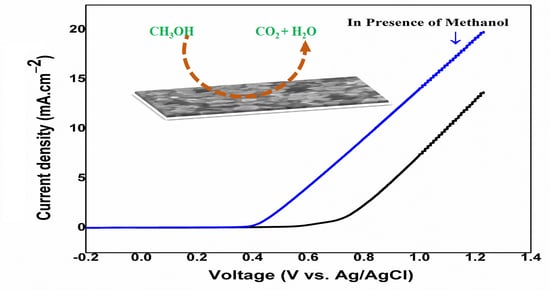Fabrication of Metal (Cu and Cr) Incorporated Nickel Oxide Films for Electrochemical Oxidation of Methanol
Abstract
:1. Introduction
2. Materials and Methods
Synthesis of Mixed Metal Oxide Thin Films
3. Results and Discussion
3.1. X-ray Diffraction
3.2. X-ray Photoelectron Spectroscopy
3.3. Surface Topography
3.4. Raman Spectroscopy
3.5. Surface Roughness Measurements
3.6. Electrochemical Oxidation of Methanol
4. Conclusions
Supplementary Materials
Author Contributions
Funding
Data Availability Statement
Acknowledgments
Conflicts of Interest
References
- Wang, P.; Zhou, Y.; Hu, M.; Chen, J. Well-dispersed NiO nanoparticles supported on nitrogen-doped carbon nanotube for methanol electrocatalytic oxidation in alkaline media. Appl. Surf. Sci. 2017, 392, 562–571. [Google Scholar] [CrossRef]
- Ni, B.; He, P.; Liao, W.; Chen, S.; Gu, L.; Gong, Y.; Wang, K.; Zhuang, J.; Song, L.; Zhou, G.; et al. Surface Oxidation of AuNi Heterodimers to Achieve High Activities toward Hydrogen/Oxygen Evolution and Oxygen Reduction Reactions. Small 2018, 14, 1703749. [Google Scholar] [CrossRef] [PubMed]
- Ni, B.; Wang, K.; He, T.; Gong, Y.; Gu, L.; Zhuang, J.; Wang, X. Mimic the Photosystem II for Water Oxidation in Neutral Solution: A Case of Co3O4. Adv. Energy Mater. 2018, 8, 1702313. [Google Scholar] [CrossRef]
- Bing Ni, Q.Z.; Ouyang, C.; Zhang, S.; Yu, B.; Zhuang, J.; Gu, L.; Wang, X. The Synthesis of Sub-Nano-Thick Pd Nanobelt–Based Materials for Enhanced Hydrogen Evolution Reaction Activity. CCS Chem. 2020, 2, 13. [Google Scholar] [CrossRef]
- Li, J.-S.; Li, S.-L.; Tang, Y.-J.; Li, K.; Zhou, L.; Kong, N.; Lan, Y.-Q.; Bao, J.-C.; Dai, Z.-H. Heteroatoms ternary-doped porous carbons derived from MOFs as metal-free electrocatalysts for oxygen reduction reaction. Sci. Rep. 2014, 4, 5130. [Google Scholar] [CrossRef] [Green Version]
- Tate, G.L.; Mehrabadi, B.A.T.; Xiong, W.; Kenvin, A.; Monnier, J.R. Synthesis of Highly Active Pd@Cu–Pt/C Methanol Oxidation Electrocatalysts via Continuous, Co-Electroless Deposition. Nanomaterials 2021, 11, 793. [Google Scholar] [CrossRef]
- Artal, R.; Serrà, A.; Michler, J.; Philippe, L.; Gómez, E. Electrodeposition of Mesoporous Ni-Rich Ni-Pt Films for Highly Efficient Methanol Oxidation. Nanomaterials 2020, 10, 1435. [Google Scholar] [CrossRef]
- Gamil, S.; El Rouby, W.M.; Antuch, M.; Zedan, I.T. Nanohybrid layered double hydroxide materials as efficient catalysts for methanol electrooxidation. RSC Adv. 2019, 9, 13503–13514. [Google Scholar] [CrossRef] [Green Version]
- Barakat, N.A.M.; El-Newehy, M.; Al-Deyab, S.S.; Kim, H.Y. Cobalt/copper-decorated carbon nanofibers as novel non-precious electrocatalyst for methanol electrooxidation. Nanoscale Res. Lett. 2014, 9, 2. [Google Scholar] [CrossRef] [Green Version]
- Xu, C.; Tian, Z.; Shen, P. Oxide (CeO2, NiO, Co3O4 and Mn3O4)-promoted Pd/C electrocatalysts for alcohol electrooxidation in alkaline media. Electrochim. Acta 2008, 53, 2610–2618. [Google Scholar] [CrossRef]
- Roy, A.; Jadhav, H.S.; Cho, M.; Seo, J.G. Electrochemical deposition of self-supported bifunctional copper oxide electrocatalyst for methanol oxidation and oxygen evolution reaction. J. Ind. Eng. Chem. 2019, 76, 515–523. [Google Scholar] [CrossRef]
- Pawar, S.; Pawar, B.; Inamdar, A.; Kim, J.; Jo, Y.; Cho, S.; Mali, S.; Hong, C.; Kwak, J.; Kim, H. In-situ synthesis of Cu(OH)2 and CuO nanowire electrocatalysts for methanol electro-oxidation. Mater. Lett. 2017, 187, 60–63. [Google Scholar] [CrossRef]
- Hassan, H.; Hamid, Z.A. Electrodeposited Ni–Cr2O3 nanocomposite anodes for ethanol electrooxidation. Int. J. Hydrog. Energy 2011, 36, 5117–5127. [Google Scholar] [CrossRef]
- Noor, T.; Pervaiz, S.; Iqbal, N.; Nasir, H.; Zaman, N.; Sharif, M.; Pervaiz, E. Nanocomposites of NiO/CuO Based MOF with rGO: An Efficient and Robust Electrocatalyst for Methanol Oxidation Reaction in DMFC. Nanomaterials 2020, 10, 1601. [Google Scholar] [CrossRef] [PubMed]
- Askari, M.B.; Salarizadeh, P.; Seifi, M.; Rozati, S.M. Ni/NiO coated on multi-walled carbon nanotubes as a promising electrode for methanol electro-oxidation reaction in direct methanol fuel cell. Solid State Sci. 2019, 97, 106012. [Google Scholar] [CrossRef]
- Su, D.S.; Sun, G. Nonprecious-Metal Catalysts for Low-Cost Fuel Cells. Angew. Chem. Int. Ed. 2011, 50, 11570–11572. [Google Scholar] [CrossRef]
- Mansoor, M.A.; Munawar, K.; Lim, S.P.; Huang, N.M.; Mazhar, M.; Akhtar, M.J.; Siddique, M. Iron–manganese–titanium (1:1:2) oxide composite thin films for improved photocurrent efficiency. New J. Chem. 2017, 41, 7322–7330. [Google Scholar] [CrossRef]
- Ahmed, S.; Mansoor, M.A.; Basirun, W.J.; Sookhakian, M.; Huang, N.M.; Mun, L.K.; Sohnel, T.; Arifin, Z.; Mazhar, M. The synthesis and characterization of a hexanuclear copper-yttrium complex for deposition of semiconducting CuYO2-0.5Cu2O composite thin films. New J. Chem. 2015, 39, 1031–1037. [Google Scholar] [CrossRef]
- Wang, J.; Teschner, D.; Yao, Y.; Huang, X.; Willinger, M.; Shao, L.; Schlögl, R. Fabrication of nanoscale NiO/Ni heterostructures as electrocatalysts for efficient methanol oxidation. J. Mater. Chem. A 2017, 5, 9946–9951. [Google Scholar] [CrossRef] [Green Version]
- Yu, J.; Ni, Y.; Zhai, M. Simple solution-combustion synthesis of Ni-NiO@ C nanocomposites with highly electrocatalytic activity for methanol oxidation. J. Phys. Chem. Solids 2018, 112, 119–126. [Google Scholar] [CrossRef]
- Calderón, J.C.; Rios Ráfales, M.; Nieto-Monge, M.J.; Pardo, J.I.; Moliner, R.; Lázaro, M.J. Oxidation of CO and Methanol on Pd-Ni Catalysts Supported on Different Chemically-Treated Carbon Nanofibers. Nanomaterials 2016, 6, 187. [Google Scholar] [CrossRef] [PubMed] [Green Version]
- Hassan, H.; Tammam, R.H. Preparation of Ni-metal oxide nanocomposites and their role in enhancing the electro-catalytic activity towards methanol and ethanol. Solid State Ion. 2018, 320, 325–338. [Google Scholar] [CrossRef]
- Al-Enizi, A.; Ghanem, M.A.; El-Zatahry, A.; Al-Salem, S. Nickel oxide/nitrogen doped carbon nanofibers catalyst for methanol oxidation in alkaline media. Electrochim. Acta 2014, 137, 774–780. [Google Scholar] [CrossRef]
- Kim, J.-W.; Park, S.-M. Electrochemical oxidation of ethanol at nickel hydroxide electrodes in alkaline media studied by electrochemical impedance spectroscopy. J. Korean Electrochem. Soc. 2005, 8, 117–124. [Google Scholar] [CrossRef] [Green Version]
- Gu, Y.; Luo, J.; Liu, Y.; Yang, H.; Ouyang, R.; Miao, Y. Synthesis of bimetallic Ni–Cr nano-oxides as catalysts for methanol oxidation in NaOH solution. J. Nanosci. Nanotechnol. 2015, 15, 3743–3749. [Google Scholar] [CrossRef]
- Theres, G.S.; Velayutham, G.; Krishnan, P.S.; Shanthi, K. Synergistic impact of Ni–Cu hybrid oxides deposited on ordered mesoporous carbon scaffolds as non-noble catalyst for methanol oxidation. J. Mater. Sci. 2019, 54, 1502–1519. [Google Scholar] [CrossRef]
- Jlassi, M.; Sta, I.; Hajji, M.; Ezzaouia, H. Optical and electrical properties of nickel oxide thin films synthesized by sol–gel spin coating. Mater. Sci. Semicond. Process. 2014, 21, 7–13. [Google Scholar] [CrossRef]
- Sun, S.; Xu, Z.J. Composition dependence of methanol oxidation activity in nickel–cobalt hydroxides and oxides: An optimization toward highly active electrodes. Electrochim. Acta 2015, 165, 56–66. [Google Scholar] [CrossRef]
- An, W.-J.; Thimsen, E.; Biswas, P. Aerosol-chemical vapor deposition method for synthesis of nanostructured metal oxide thin films with controlled morphology. J. Phys. Chem. Lett. 2010, 1, 249–253. [Google Scholar] [CrossRef]
- Daraz, U.; Ansari, T.M.; Arain, S.A.; Mansoor, M.A.; Mazhar, M. Study of solvent effect on structural and photoconductive behavior of ternary chalcogenides InBiS3-In2S3-Bi2S3 composite thin films deposited via AACVD. Main Group Met. Chem. 2019, 42, 102–112. [Google Scholar] [CrossRef]
- Munawar, K.; Mansoor, M.A.; Olmstead, M.M.; Yusof, F.B.; Misran, M.B.; Basirun, W.J.; Mazhar, M. Pyrochlore-structured Y2Ti2O7–2TiO2 composite thin films for photovoltaic applications. J. Aust. Ceram. Soc. 2019, 55, 921–932. [Google Scholar] [CrossRef]
- Amri, A.; Hasan, K.; Taha, H.; Rahman, M.M.; Herman, S.; Awaltanova, E.; Kabir, H.; Yin, C.-Y.; Ibrahim, K.; Bahri, S.; et al. Surface structural features and optical analysis of nanostructured Cu-oxide thin film coatings coated via the sol-gel dip coating method. Ceram. Int. 2019, 45, 12888–12894. [Google Scholar] [CrossRef]
- Meenakshi, L.J.; Aswathy, B.R.; Manoj, P.K. Effect of Annealing Temperature on Structural and Optical Properties of Nickel Oxide Thin Films by Dip Coating Method. In Proceedings oof the AIP Conference, Kollam, India, 12–14 December 2019. [Google Scholar] [CrossRef]
- Ghalmi, Y.; Habelhames, F.; Sayah, A.; Bahloul, A.; Nessark, B.; Shalabi, M.; Nunzi, J.M. Capacitance performance of NiO thin films synthesized by direct and pulse potentiostatic methods. Ionics 2019, 25, 6025–6033. [Google Scholar] [CrossRef]
- Akgul, F.A.; Akgul, G.; Yildirim, N.; Unalan, H.E.; Turan, R. Influence of thermal annealing on microstructural, morphological, optical properties and surface electronic structure of copper oxide thin films. Mater. Chem. Phys. 2014, 147, 987–995. [Google Scholar] [CrossRef]
- Al-Saadi, T.M.; Hameed, N.A. Synthesis and structural characterization of Cr2O3 nanoparticles prepared by using Cr(NO3)3·9H2O and triethanolamine under microwave irradiation. Adv. Phys. Theor. Appl. Synth. 2015, 44, 139–148. [Google Scholar]
- Naeem, R.; Yahya, R.; Mansoor, M.A.; Teridi, M.A.M.; Sookhakian, M.; Mumtaz, A.; Mazhar, M. Photoelectrochemical water splitting over mesoporous CuPbI3 films prepared by electrophoretic technique. Mon. Chem.-Chem. Mon. 2017, 148, 981–989. [Google Scholar] [CrossRef]
- Lu, Q.; Huang, R.; Wang, L.; Wu, Z.; Li, C.; Luo, Q.; Zuo, S.; Li, J.; Peng, D.; Han, G.L.; et al. Thermal annealing and magnetic anisotropy of NiFe thin films on n+-Si for spintronic device applications. J. Magn. Magn. Mater. 2015, 394, 253–259. [Google Scholar] [CrossRef]
- Kalita, C.; Sarkar, R.D.; Verma, V.; Bharadwaj, S.K.; Kalita, M.C.; Boruah, P.K.; Das, M.R.; Saikia, P. Bayesian Modeling Coherenced Green Synthesis of NiO Nanoparticles Using Camellia sinensis for Efficient Antimicrobial Activity. BioNanoScience 2021, 11, 825–837. [Google Scholar] [CrossRef]
- Liu, W.; Lu, C.; Wang, X.; Liang, K.; Tay, B.K. In situ fabrication of three-dimensional, ultrathin graphite/carbon nanotube/NiO composite as binder-free electrode for high-performance energy storage. J. Mater. Chem. A 2015, 3, 624–633. [Google Scholar] [CrossRef]
- Li, N.; Wang, N. The effect of duplex Surface mechanical attrition and nitriding treatment on corrosion resistance of stainless steel 316L. Sci. Rep. 2018, 8, 8454. [Google Scholar] [CrossRef] [Green Version]
- Mansoor, M.A.; McKee, V.; Yusof, F.B.; Lim, S.P.; Zubir, M.N.M.; Ming, H.N.; Mazhar, M. Lanthanum–titanium oxide composite from a single molecular cluster: Non-enzymatic mesoporous electrochemical nitrite ion sensor. Polyhedron 2018, 156, 332–341. [Google Scholar] [CrossRef]
- Qiu, Z.; He, D.; Wang, Y.; Zhao, X.; Zhao, W.; Wu, H. High performance asymmetric supercapacitors with ultrahigh energy density based on hierarchical carbon nanotubes@ NiO core–shell nanosheets and defect-introduced graphene sheets with hole structure. RSC Adv. 2017, 7, 7843–7856. [Google Scholar] [CrossRef] [Green Version]
- Guha, S.; Peebles, D.; Wieting, J.T. Raman and infrared studies of cupric oxide. Bull. Mater. Sci. 1991, 14, 539–543. [Google Scholar] [CrossRef]
- Li, Q.; Gou, Y.; Wang, T.-G.; Gu, T.; Yu, Q.; Wang, L. Study on Local Residual Stress in a Nanocrystalline Cr2O3 Coating by Micro-Raman Spectroscopy. Coatings 2019, 9, 500. [Google Scholar] [CrossRef] [Green Version]



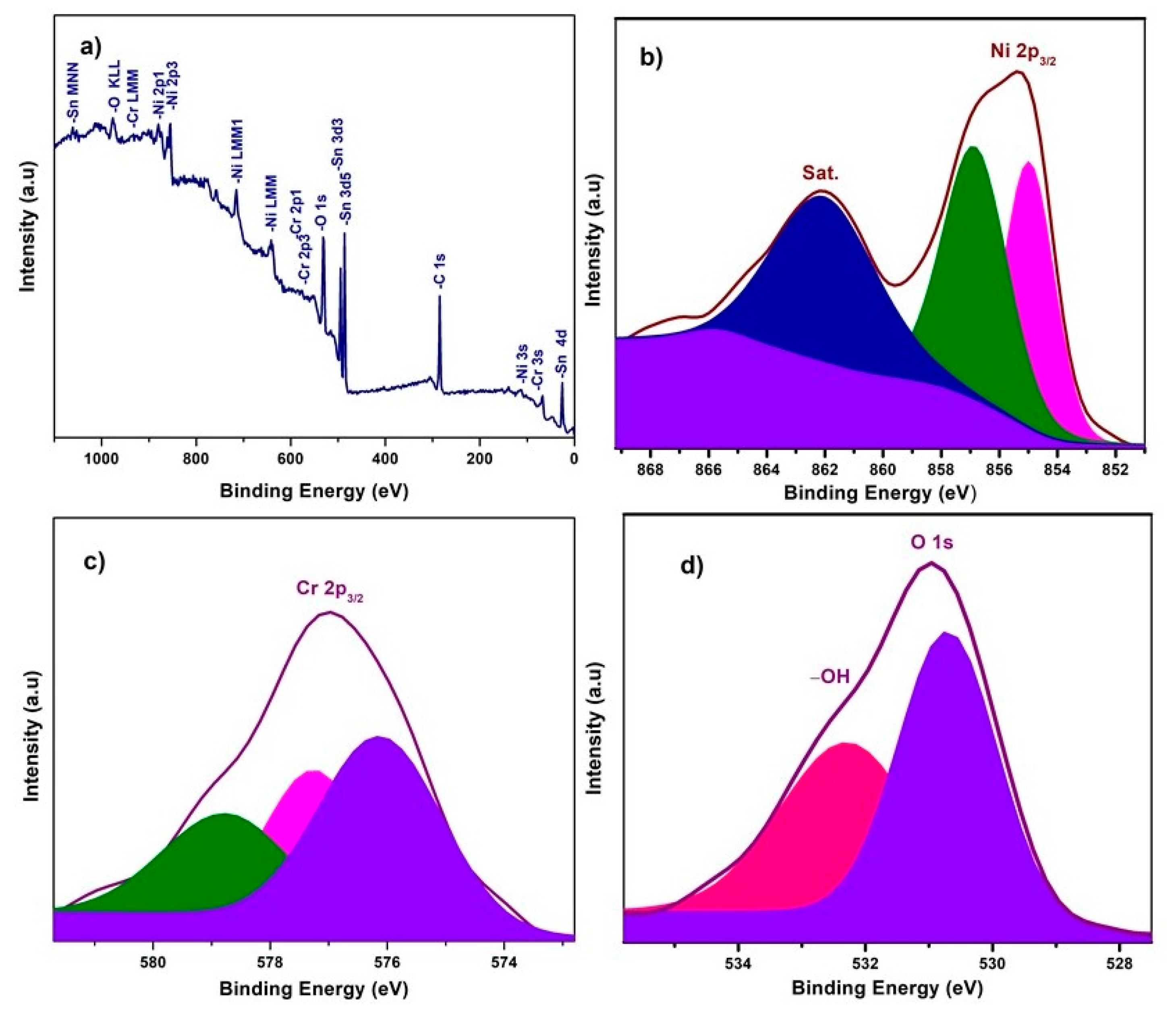
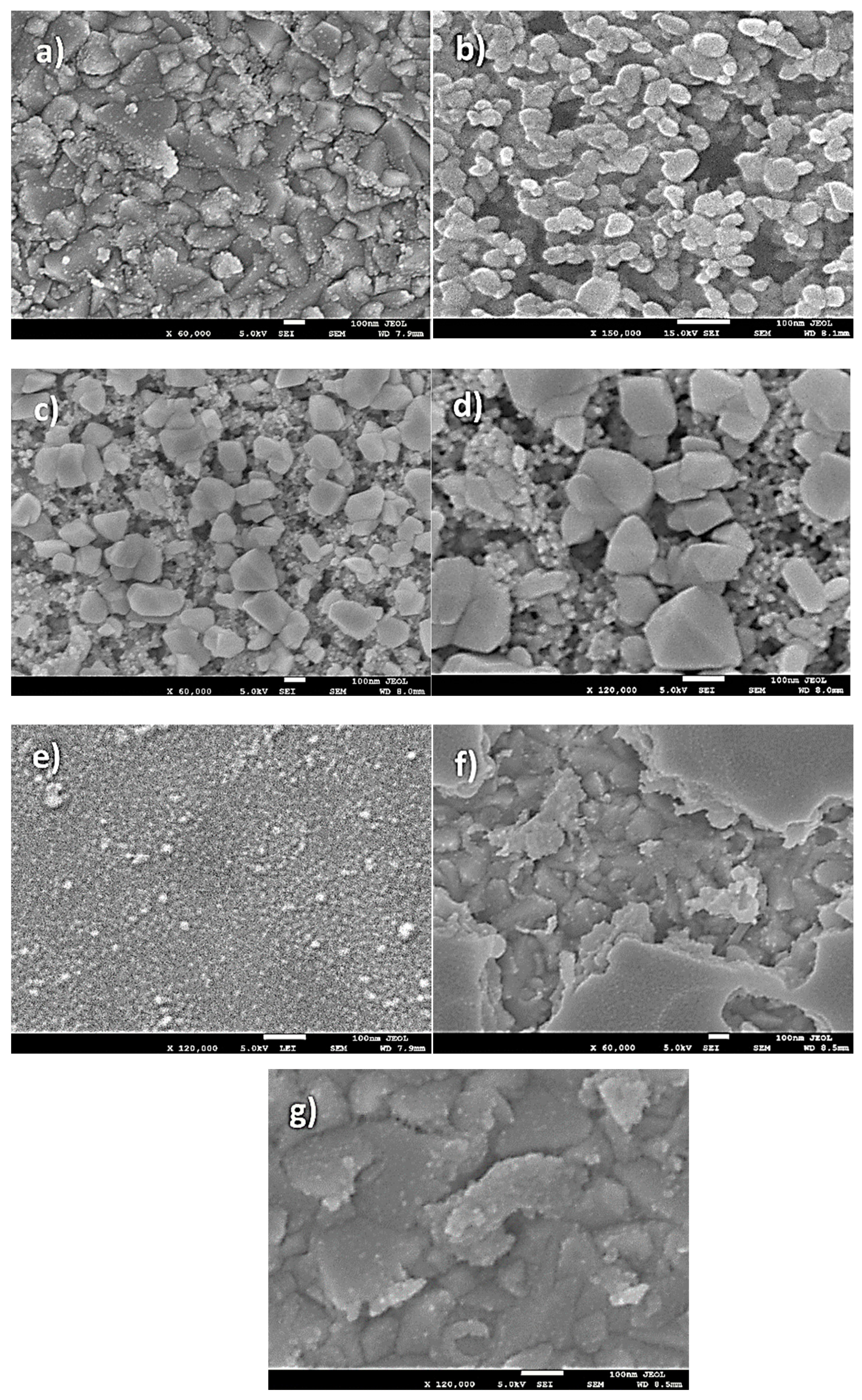

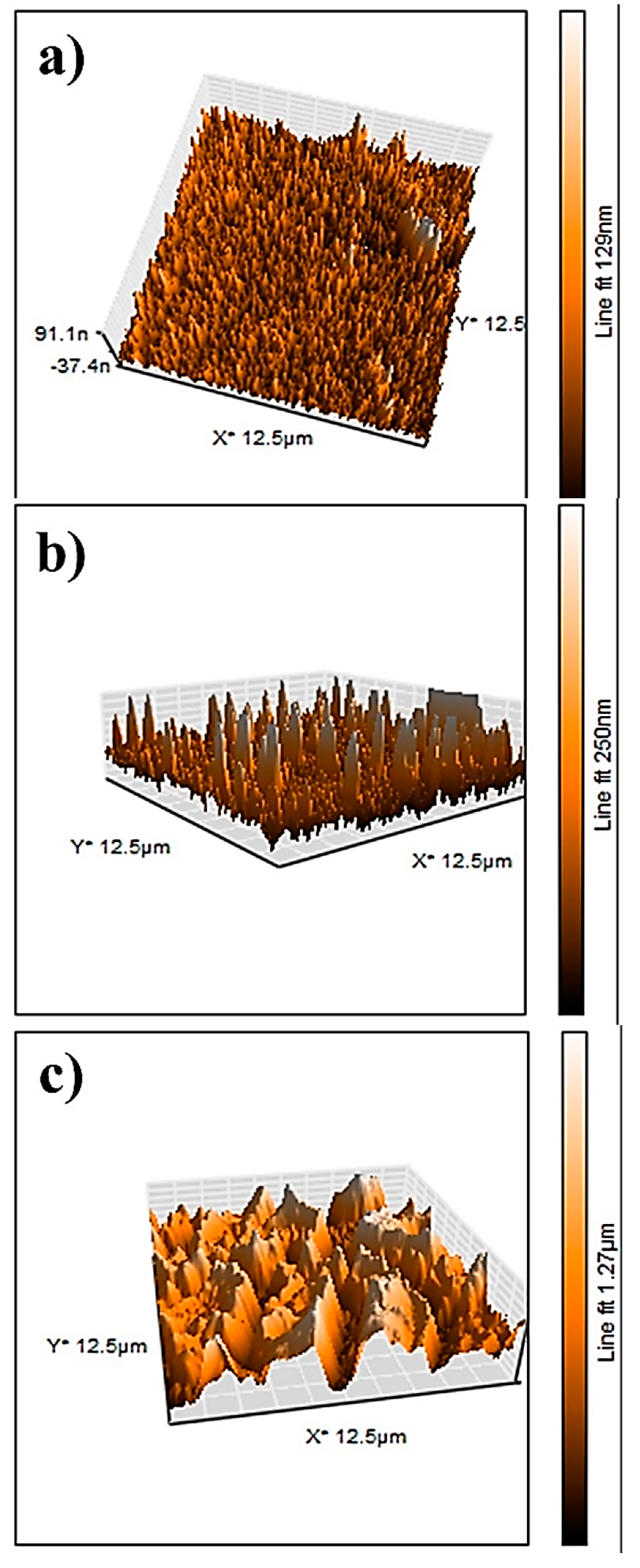

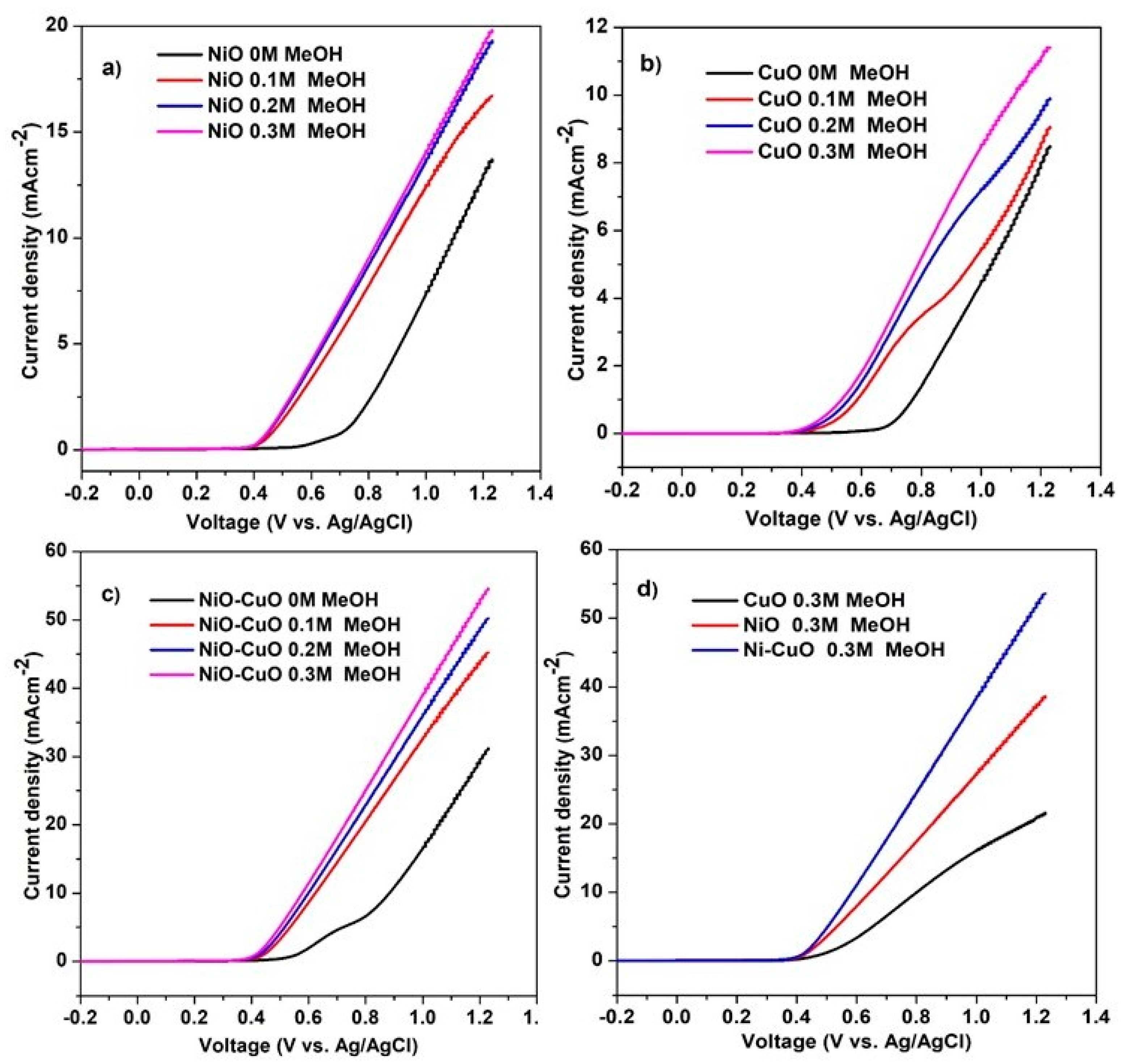
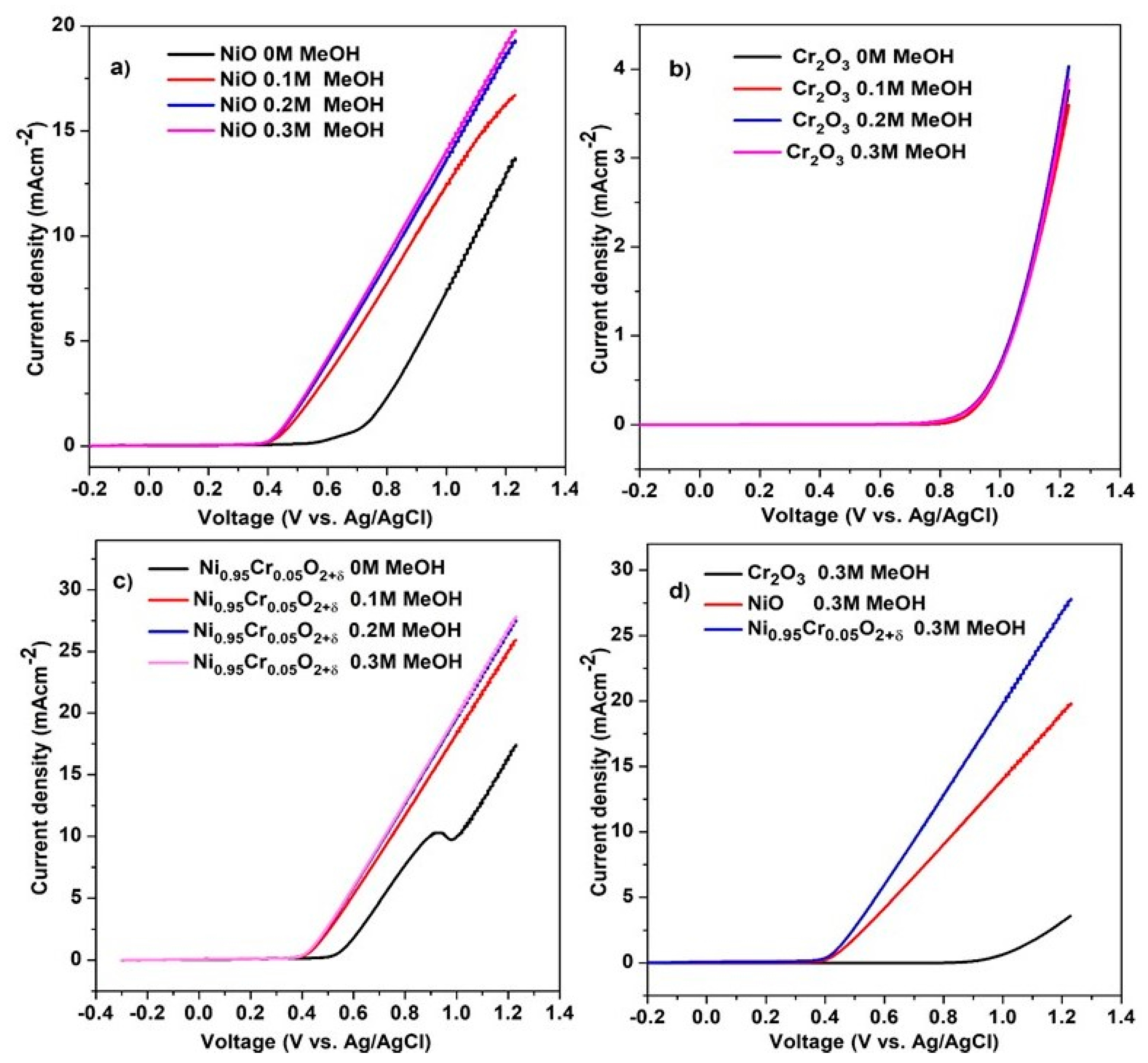
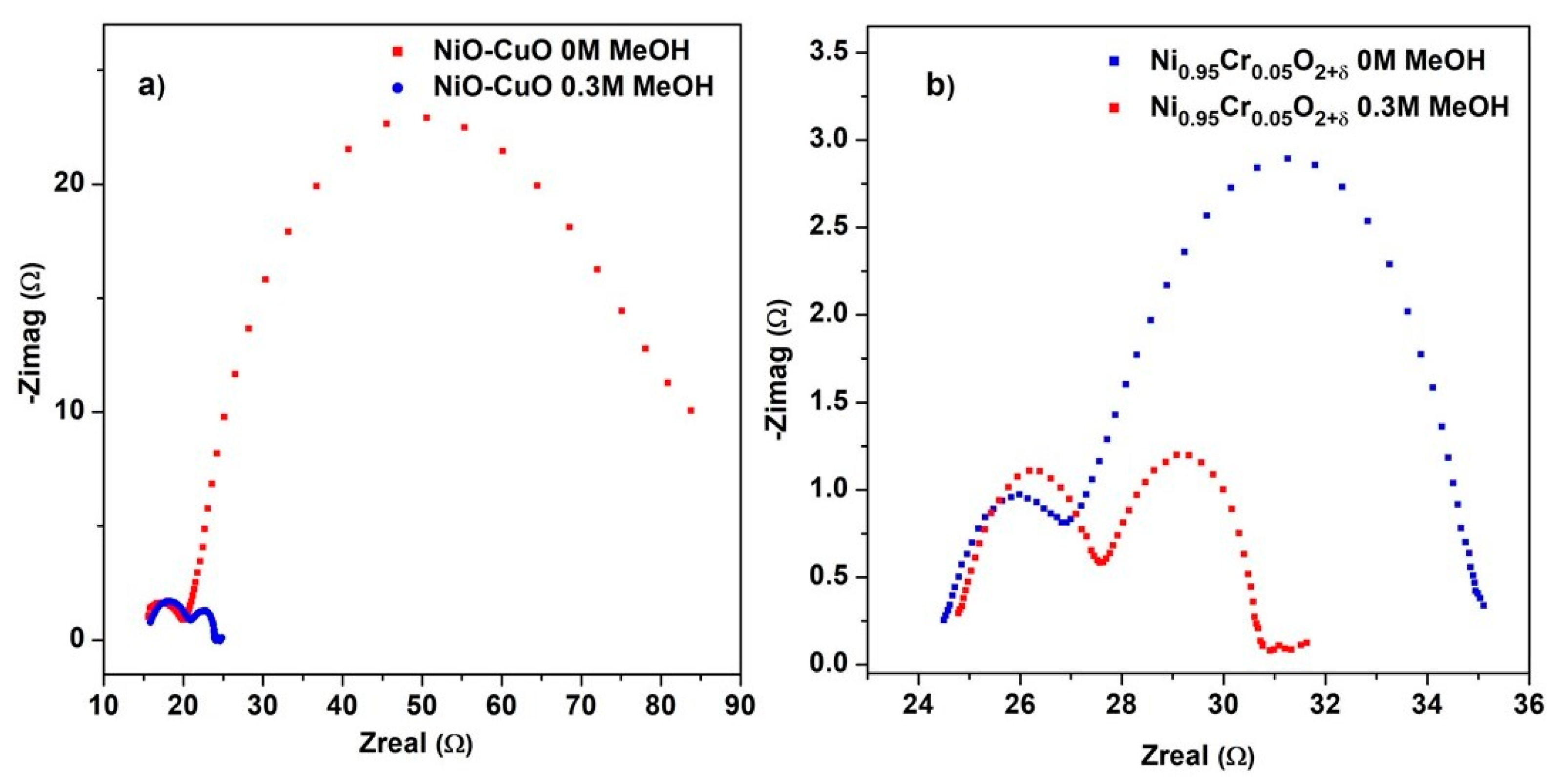

Publisher’s Note: MDPI stays neutral with regard to jurisdictional claims in published maps and institutional affiliations. |
© 2021 by the authors. Licensee MDPI, Basel, Switzerland. This article is an open access article distributed under the terms and conditions of the Creative Commons Attribution (CC BY) license (https://creativecommons.org/licenses/by/4.0/).
Share and Cite
Liaqat, R.; Mansoor, M.A.; Iqbal, J.; Jilani, A.; Shakir, S.; Kalam, A.; Wageh, S. Fabrication of Metal (Cu and Cr) Incorporated Nickel Oxide Films for Electrochemical Oxidation of Methanol. Crystals 2021, 11, 1398. https://doi.org/10.3390/cryst11111398
Liaqat R, Mansoor MA, Iqbal J, Jilani A, Shakir S, Kalam A, Wageh S. Fabrication of Metal (Cu and Cr) Incorporated Nickel Oxide Films for Electrochemical Oxidation of Methanol. Crystals. 2021; 11(11):1398. https://doi.org/10.3390/cryst11111398
Chicago/Turabian StyleLiaqat, Rimsha, Muhammad Adil Mansoor, Javed Iqbal, Asim Jilani, Sehar Shakir, Abul Kalam, and S. Wageh. 2021. "Fabrication of Metal (Cu and Cr) Incorporated Nickel Oxide Films for Electrochemical Oxidation of Methanol" Crystals 11, no. 11: 1398. https://doi.org/10.3390/cryst11111398
APA StyleLiaqat, R., Mansoor, M. A., Iqbal, J., Jilani, A., Shakir, S., Kalam, A., & Wageh, S. (2021). Fabrication of Metal (Cu and Cr) Incorporated Nickel Oxide Films for Electrochemical Oxidation of Methanol. Crystals, 11(11), 1398. https://doi.org/10.3390/cryst11111398






